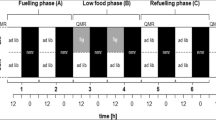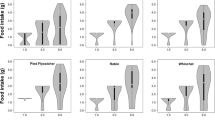Summary
Many birds accumulate fat reserves prior to departure on long distance migration. Since there will be an increased food requirement during the pre-migratory period, it is to be expected that more time will be invested in foraging, at the expense of other activities. The allocation of time to anti-predatory behavior in migratory ruddy turnstones (adults) was found to decrease prior to migration (Fig. 1); non-migratory individuals (juveniles) showed no decrease over the same time period (Fig. 2). This is interpreted as a change in the optimal adult behavior, the cost of a reduced rate of resource accumulation outweighing the additional risk of predation which results from the decrease in vigilance.
Similar content being viewed by others
References
Barnard CJ (1980) Flock feeding and time budgets in the house sparrow (Passer domesticus). Anim Behav 28:295–309
Branson NJBA, Ponting ED, Minton CDT (1978) Turnstone migrations in Britain and Europe. Bird Study 25:181–187
Branson NJBA, Ponting ED, Minton CDT (1979) Turnstone populations on the Wash. Bird Study 26:47–54
Caraco T (1980) Time budgets and flocking dynamics. Proc XVIII Int Ornithol Congr 1978
Caraco T, Martindale S, Pulliam HR (1980) Avian time budgets and distance to cover. Auk 97:872–875
Clapham C (1979) The turnstone populations of Morecambe Bay. Ringing Migration 2:144–150
Covich AP (1976) Analyzing shapes of foraging areas: some ecological and economic theories. Annu Rev Ecol Syst 7:235–258
Cramp S, Simmons KEL (eds) (1982) The birds of the western Palearctic, vol 3, Oxford University Press, Oxford
Evans PR (1981) Migration and dispersal of shorebirds as a survival strategy. In: Jones NV, Wolff WJ (eds) Feeding and survival strategies of estuarine organisms. Plenum Press, New York (Marine science, vol 3, pp 275–290)
Goldman P (1980) Flocking as a possible predator defense in dark-eyed juncos. Wilson Bull 92:88–95
Goss-Custard JD (1980) Competition for food and interference among waders. Ardea 68:31–52
Heller R, Milinski M (1979) Optimal foraging of sticklebacks on swarming prey. Anim Behav 27:1127–1141
Krebs JR (1978) Optimal foraging: decision rules for predators. In: Krebs JR, Davies NB (eds) Behavioural ecology: an evolutionary approach, Blackwell, Oxford, pp 23–63
Krebs JR (1980) Optimal foraging, predator risk and territory defence. Ardea 68:83–90
McCleery RH (1978) Optimal behaviour sequences and decision making. In: Krebs JR, Davies NB (eds) Behavioural ecology: an evolutionary approach. Blackwell, Oxford, pp 377–410
Metcalfe NB (in press a) The effects of habitat on the vigilance of shorebirds: is visibility important? Anim Behav
Metcalfe NB (in press b) The effects of mixed species flocking on the vigilance of shorebirds: who do they trust? Anim Behav
Milinski M, Heller R (1978) Influence of a predator on the optimal foraging behaviour of sticklebacks (Gasterosteus aculeatus L). Nature 275:642–644
Morrison RIG (1975) Migration and morphometrics of European knot and turnstone on Ellesmere Island, Canada. Bird-Banding 46:290–301
Page G, Middleton ALA (1972) Fat depositions during autumn migration in the semi-palmated sandpiper. Bird-Banding 43:85–96
Page G, Whitacre DF (1975) Raptor predation on wintering shorebirds. Condor 77:73–83
Parmelee DF, MacDonald SD (1960) The birds of west-central Ellesmere Island and ajacent areas. Natl Mus Can Bull 169
Powell GVN (1974) Experimental analysis of the social value of flocking by starlings (Sturnus vulgaris) in relation to predation and foraging. Anim Behav 27:501–505
Prater AJ, Marchant JH, Vuorinen J (1977) Guide to the identification and ageing of Holarctic waders. Br Trust Ornithol, Tring
Pulliam HR (1973) On the advantages of flocking. J Theor Biol 38:419–422
Pulliam HR (1976) The principle of optimal behaviour and the theory of communities. In: Bateson PPG, Klopfer PH (eds) Perspectives in ethology, vol 2. Plenum Press, New York, pp 311–332
Recher HF, Recher JA (1969) Some aspects of the ecology of migrant shorebirds. II. Aggression. Wilson Bull 81: 140–154
Schoener TW (1971) Theory of feeding strategies. Annu Rev Ecol Syst 2:369–404
Sih A (1980) Optimal behavior: can foragers balance two conflicting demands? Science 210:1041–1043
Sih A (1982a) Foraging strategies and the avoidance of predation by an aquatic insect, Notonecta hoffmani. Ecology 63:786–796
Sih A (1982b) Optimal patch use: variation in selective pressure for efficient foraging. Am Nat 20:666–685
Sutherland WJ, Koene P (1982) Field estimates of the strength of interference between oystercatchers Haematopus ostralegus. Oecologia (Berl) 55:108–109
Wilson JR (1981) The migration of high arctic shorebirds through Iceland. Bird Study 28:21–32
Author information
Authors and Affiliations
Rights and permissions
About this article
Cite this article
Metcalfe, N.B., Furness, R.W. Changing priorities: the effect of pre-migratory fattening on the trade-off between foraging and vigilance. Behav Ecol Sociobiol 15, 203–206 (1984). https://doi.org/10.1007/BF00292976
Received:
Accepted:
Issue Date:
DOI: https://doi.org/10.1007/BF00292976




